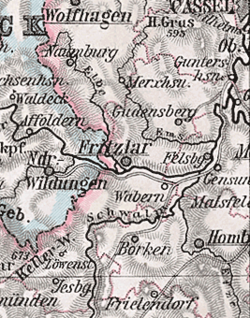Fritzlar district
| Basic data | |
|---|---|
| Prussian Province | Hessen-Nassau |
| Administrative district | kassel |
| County seat | Fritzlar |
| Inventory period | 1821-1932 |
| surface | 341.1 km² |
| Residents | 29,239 (1925) |
| Population density | 86 inhabitants / km² (1925) |
| Communities | 50 (1932) |

|
|
The Fritzlar district was an Kurhessischer and from 1866 Prussian district in the administrative district of Kassel that existed from 1821 to 1932 (with the exception of the years 1849 to 1851) . The district town was Fritzlar , the district area comprised the north-western part of today's Schwalm-Eder district .
history
The area of the Fritzlar district stretched like a long hose from Niedenstein and Holzhausen (Hahn) in the north to Jesberg and Densberg in the southwest. It was bordered in the west by the Wolfhagen district and the principality of Waldeck (later the Free State of Waldeck), in the east by the districts of Melsungen and Homberg and in the south by the district of Ziegenhain .
The Fritzlar district was established in 1821, in execution of the electoral organizational edict of June 29, 1821, as a district of the Hessian province of Niederhessen from the three previous offices Fritzlar , Gudensberg and Jesberg as well as parts of the offices of Borken (the villages of Gombeth , Großenenglis , Kleinenglis , Kerstenhausen and Udenborn ) and Homberg (the villages of Uttershausen , Wabern and Zennern ). The districts took over the administrative tasks of the offices; for case law in the first instance the offices were Fritzlar , Gudensberg and Jesberg case in judicial authorities converted.
On January 1, 1837, the municipality of Römersberg moved from the Fritzlar district to the Homberg district. At the same time, the community of Densberg moved from the district of Ziegenhain to the district of Fritzlar. On November 18, the community of Gombeth moved from the Fritzlar district to the Homberg district.
The Fritzlar district in 1842 included the towns of Fritzlar , Gudensberg and Niedenstein , as well as 48 villages and 10 farms with a total of 3,725 houses and 28,516 inhabitants.
As a result of the March Revolution , the district was combined with the Homberg and Ziegenhain districts to form the Fritzlar district in 1848 . This reorganization was reversed in 1851. Even after the annexation of Kurhesse by Prussia in 1866, the Fritzlar district remained in existence - from December 1868 in the newly created province of Hessen-Nassau .
On January 1, 1908, the district comprised three urban parishes, 47 rural parishes and 8 manor districts . The manor districts were dissolved in the 1920s.
Due to the compulsion to cost-cutting measures in the wake of the global economic crisis of 1929, the county was Fritzlar in 1932 as part of the so-called small administrative reform in Prussia with the county Homberg to circle Fritzlar-Homberg merged, which was renamed the county Fritzlar-Homberg on 1 January 1939th In 1974 this was combined with the districts of Melsungen and Ziegenhain to form the Schwalm-Eder district .
Population development
The following table shows the population development for the Fritzlar district:
| year | Residents |
|---|---|
| 1842 | 28,516 |
| 1871 | 25,684 |
| 1890 | 26,482 |
| 1900 | 26,466 |
| 1910 | 27,174 |
| 1925 | 29,239 |
District administrators
The Fritzlar district had the following district administrators:
- Edwin von Bischoffshausen (1852)
- Christian Ludwig Weber (1852–1868)
- Eduard von Goeddaeus (1868)
- Karl von Eschwege (1868–1890)
- Heinrich Noeldechen (1890–1922)
- Rudolf Usinger (February 1923 - August 1925)
- Max Fritz Mulert (August 1925 - August 1929)
- Heinrich Treibert (August 1929 - September 30, 1932)
Communities
Boroughs
Rural communities
Estates
|
|
literature
- Georg Landau : Description of the Electorate of Hesse . Theodor Fischer, Kassel 1842 ( PDF 42.6MB [accessed December 17, 2008]).
- Werner Ide: From Adorf to Zwesten . Local history pocket book for the Fritzlar-Homberg district. Bernecker Verlag, Melsungen 1972.
Web links
Individual evidence
- ^ Municipal directory 1910: District Fritzlar
- ^ A b Michael Rademacher: German administrative history from the unification of the empire in 1871 to the reunification in 1990. District Fritzlar-Homberg. Inhabitants of the Fritzlar district. (Online material for the dissertation, Osnabrück 2006).
- ^ Georg Landau: Office Fritzlar . In: Description of the Electorate of Hesse . Theodor Fischer, Kassel 1842, p. 225–249 ( PDF 42.6MB [accessed December 17, 2008]).
- ↑ Ordinance of June 29, 1821 on the restructuring of the previous state administration , in (collection of laws, ordinances, notices and other general orders for Kurhessen from the year 1821, court and orphanage printer, Cassel) kurhess GS 1821, p. 29 -62; also in: Wilhelm Möller and Karl Fuchs (eds.), Collection of the legal provisions still valid in the Electorate of Hesse from 1813 to 1860, Marburg and Leipzig (Elwert'sche Universitäts-Buchhandlung) 1866, pp. 311–351
- ↑ Ulrich Reuling : Administrative division 1821-1955. (PDF) In: Historical Atlas of Hesse. Landesgeschichtliches Informationssystem Hessen (LAGIS), p. 176 , accessed on March 19, 2016 .
- ↑ Werner Ide: From Adorf to Zwesten . Local history pocket book for the Fritzlar-Homberg district. Bernecker Verlag, Melsungen 1972.
- ↑ http://www.territorial.de/kurhess/fritzhom/gem1908f.htm
- ^ The municipalities and manor districts of the Hesse-Nassau province and their population in 1871
- ↑ Rolf Jehnke: County Fritzlar-Homberg . In: Territorial changes in Germany and German administered areas 1874 - 1945 . Herdecke 2006 ( HTML [accessed December 17, 2008]).
- ↑ 1945–1948 District Administrator in the district of Ziegenhain